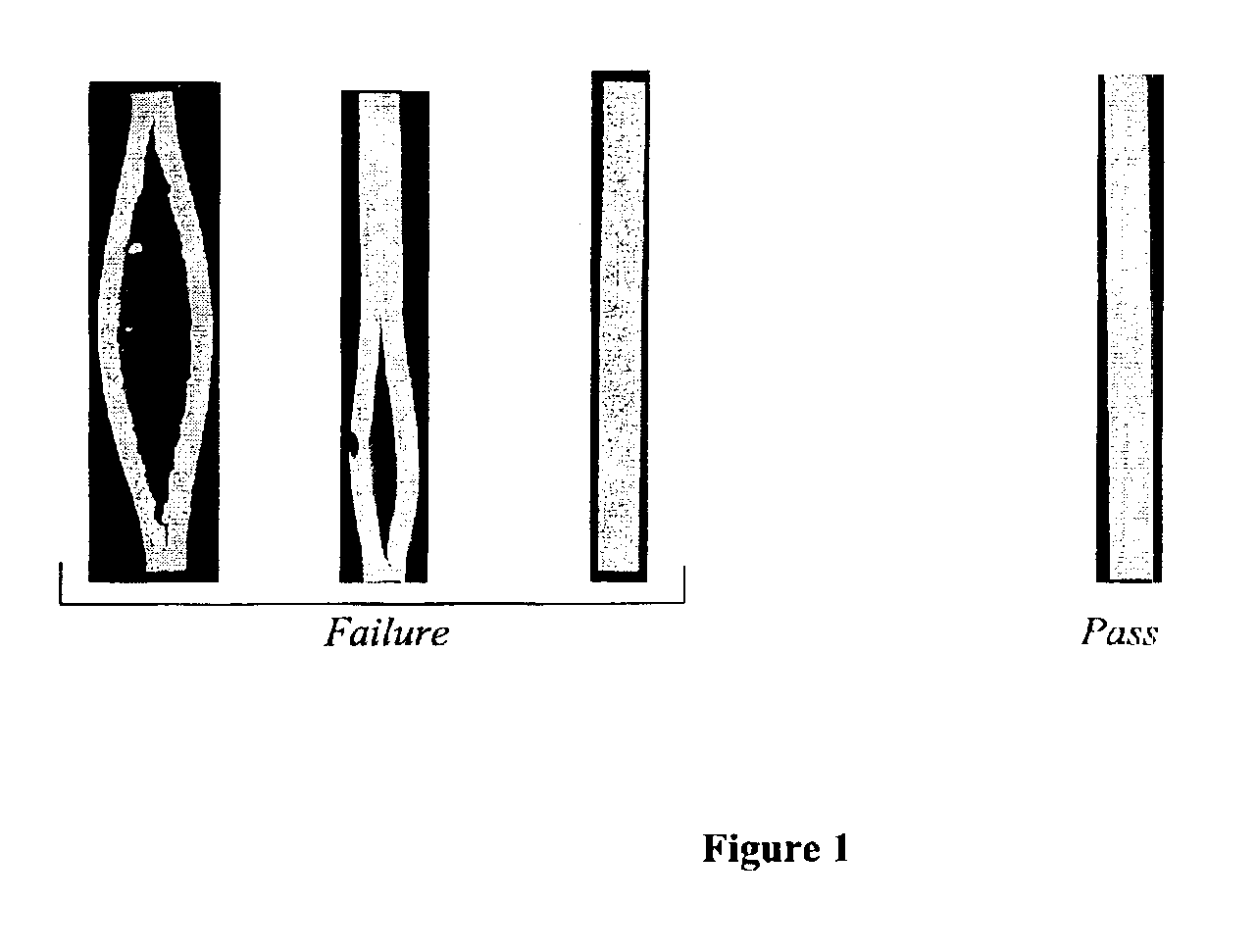Molded foam articles prepared with reduced mold residence time and improved quality
a technology of molded foam and residence time, applied in the direction of coatings, etc., can solve the problems of severe practical limits on the minimum mold residence time, part to swell and/or crack, and part unsuitable for us
- Summary
- Abstract
- Description
- Claims
- Application Information
AI Technical Summary
Benefits of technology
Problems solved by technology
Method used
Image
Examples
example 1
[0241]According to the fast demold protocol, 45 screening evaluations were conducted using the base polyol blend shown in Table I. Table II outlines the fast demold results for various surfactants and surfactant concentrations. The concentrations of surfactant 1 and surfactant 2 noted in Table II are weight percentages relative to the total blend weight of surfactant and polyol blend of Table I. The isocyanate used with the system in Table I was RUBINATE® 8700 isocyanate. The weight ratio of the isocyanate to polyol blend was 1.67, and the total reaction mixture blend weight was 175-g. This blend weight results in a molded density of approximately 0.37-g / cm3.
[0242]
TABLE IComponentWeight Percent (%)JEFFOL ® G30-650 polyol76.47Glycerine5.74POLYCAT ® 8 catalyst2.68DABCO ® 8800 catalyst0.76LOXIOL ® G71S polyester7.65UNITOL ® DSR fatty acid4.97KEMESTER ® 5721 tridecyl octadecanoate0.84Water0.89
[0243]
TABLE IIConcentrationConcentrationof Surfactantof Surfactant1 in TABLE I2 in TABLE IFast ...
example 2
[0244]In accordance with the fast demold protocol, 11 screening tests were conducted using the polyol blend shown in Table III. Table IV outlines the fast demold results for the various fatty esters and fatty ester concentrations. The fatty ester concentrations noted in Table IV are weight percentages relative to the total blend weight of fatty ester and polyol blend of Table III. The isocyanate used with the system in Table III was RUBINATE® 8700 isocyanate. The weight ratio of the isocyanate to polyol blend was 1.61, and the total reaction mixture blend weight was 175-g. This blend weight results in a molded density of approximately 0.37-g / cm3.
[0245]
TABLE IIIComponentWeight Percent (%)JEFFOL ® G30-650 polyol82.06Glycerine6.15POLYCAT ® 8 catalyst2.87DABCO ® 8800 catalyst0.82UNITOL ® DSR fatty acid5.33KEMESTER ® 5721 tridecyl octadecanoate0.91REACTINT ® X77 colorant0.33NIAX ® L550 surfactant0.81Water0.72
[0246]
TABLE IVConcentration of fattyester in TABLE IIITestPolyol BlendFast Demol...
example 3
[0247]Table V shows fast demold performance for several screening tests. All formulations are tested according to the fast demold protocol with the exception of the 3.5 overpack guideline; all systems were blended such that the total reaction mixture blend weight was 175-g. This blend weight results in a molded density of approximately 0.37-g / cm3. RUBINATE® 8700 isocyanate was the isocyanate used for all polyol blends in Table V. The A / B value refers to the weight ratio of the isocyanate to the polyol blend.
[0248]
TABLE VFormulation NumberWeight Percent (%)Polyol Blend123456789JEFFOL ® G30-65080.41 77.34 74.95 71.75 75.40 75.25 75.09 ——polyolGlycerine6.035.805.625.385.655.645.635.445.97Polyol A————————73.77 DALTOLAC ® P130———————67.23 —polyoldipropylene glycol———————7.92—JEFFCAT ®————————1.74PMDETA catalystJEFFCAT ® DMCHA2.332.712.622.512.642.632.631.58—catalystDABCO ® 88000.760.770.750.720.750.750.750.40—catalystNIAX ® L5500.800.770.740.711.001.001.001.000.50surfactantNIAX ® L6980——...
PUM
| Property | Measurement | Unit |
|---|---|---|
| Fraction | aaaaa | aaaaa |
| Temperature | aaaaa | aaaaa |
| Temperature | aaaaa | aaaaa |
Abstract
Description
Claims
Application Information
 Login to View More
Login to View More - R&D
- Intellectual Property
- Life Sciences
- Materials
- Tech Scout
- Unparalleled Data Quality
- Higher Quality Content
- 60% Fewer Hallucinations
Browse by: Latest US Patents, China's latest patents, Technical Efficacy Thesaurus, Application Domain, Technology Topic, Popular Technical Reports.
© 2025 PatSnap. All rights reserved.Legal|Privacy policy|Modern Slavery Act Transparency Statement|Sitemap|About US| Contact US: help@patsnap.com

